The restoration efforts of the Kilmanagh are showing great signs of progress. When this post was first published, many feared that the iconic general store was going to fall in. The store and the little town surrounding it were still life subjects for artists. One model maker from Germany made a scale model of the store based on photographs found on the web. (Which I wish I would have saved!)
Table of Contents
Video – Kilmanagh, Michigan: When Four Corners Made a Town
The Famous General Store
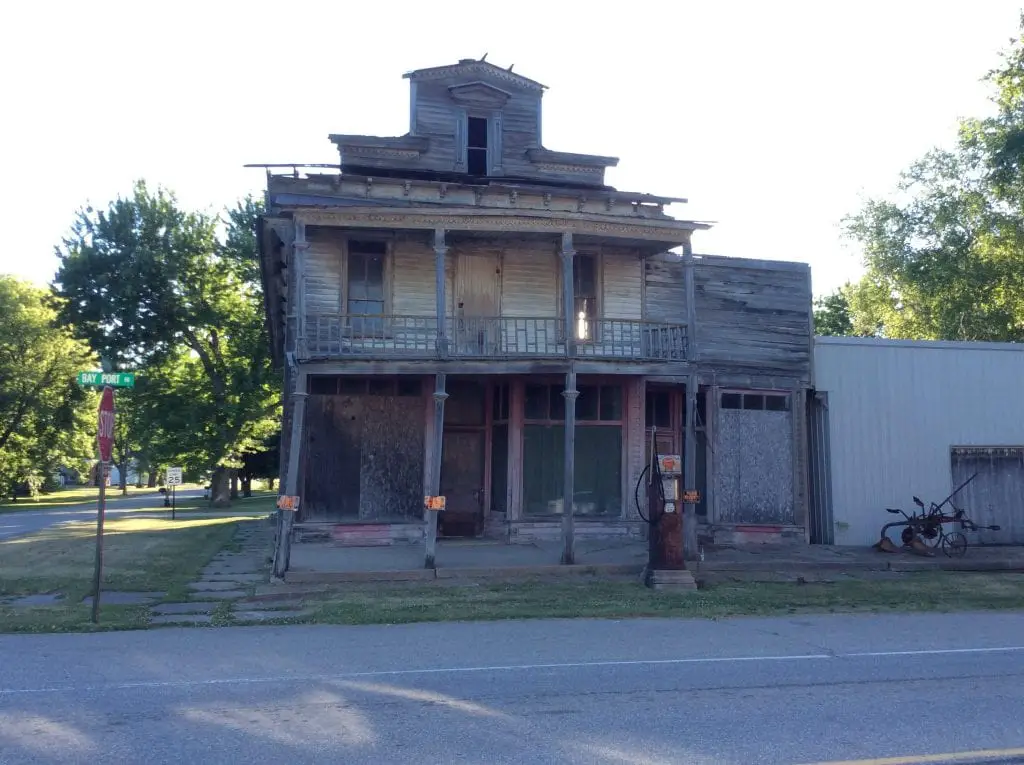
The Rummel and Woldt General Store is being transformed. The owner, Tim Voss is literally doing a labor of love to restore one of the last general stores in Michigan. He has made great progress.
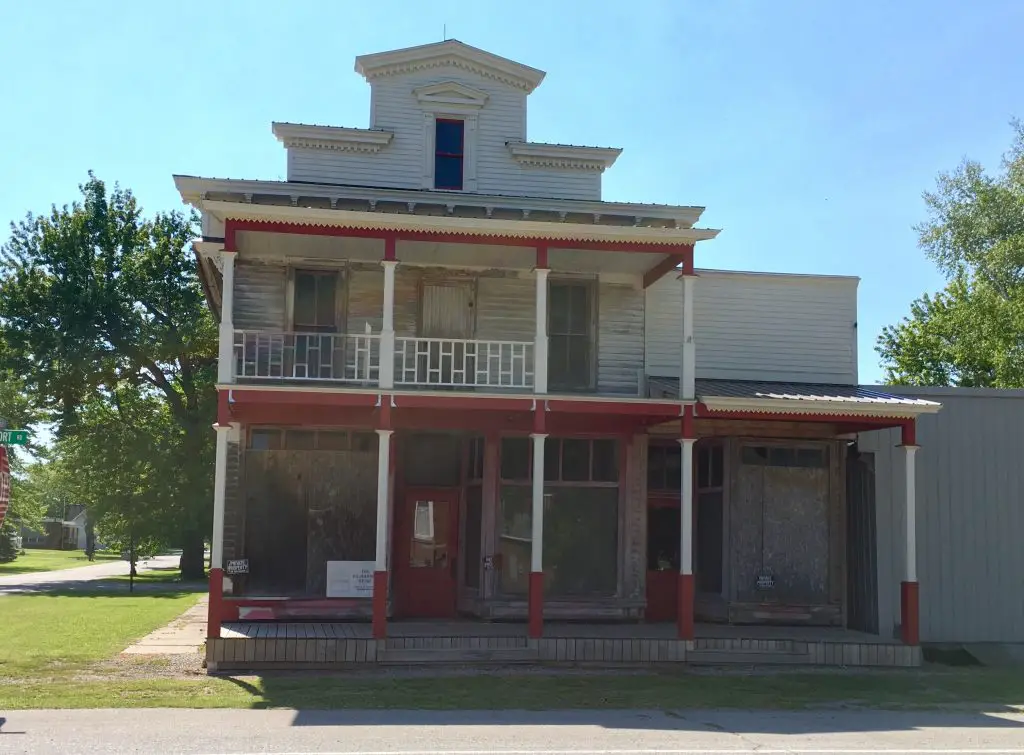
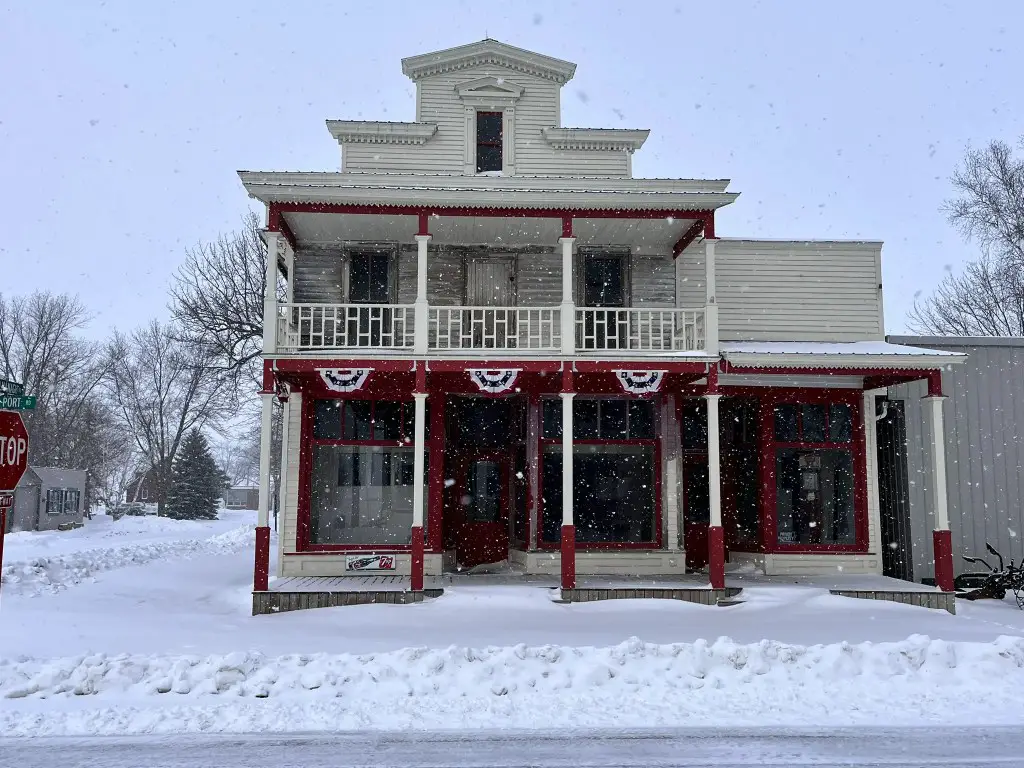
You can keep track of the restoration progress and even donate to the effort at the Kilmanagh Store page on Facebook.
The Road to Kilmanagh
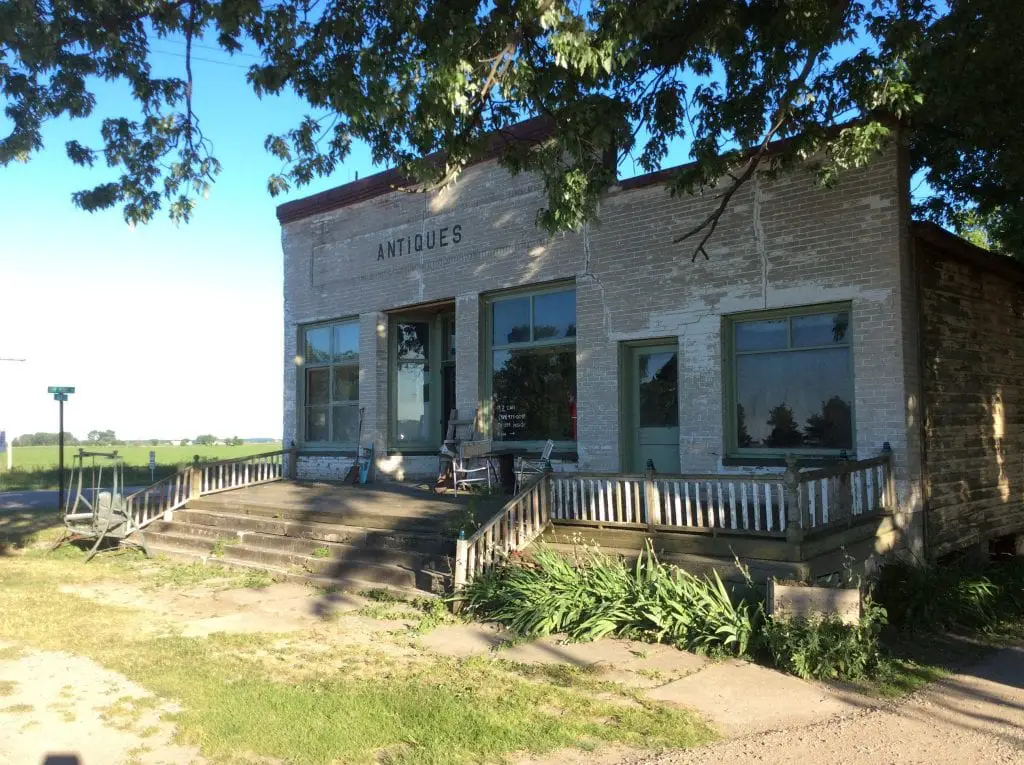
So the situation is this… it’s a typical Michigan road trip. You’re hurling along Colwood Road north of Caro toward the Saginaw Bay shore, and you start seeing signs to slow down. First, it’s Bach. A nondescript place on a map with no stop sign, and no light, but you notice a huge Pepsi-Cola/ General Store painted on one side of a building. This is the first of your ghost town road stops. Bach is a place where unknown but talented photographers go to hone their craft. Many come to places like Bach and end up with a few shots that end up on Etsy, hoping to sell a Canvas shot online for $9.99. I stop and snap a few myself.

Bach General Store Now an Abandoned Museum

It’s a disheartening sight. The sign on the front beckons potential customers to call a phone number or knock on the main house’s door for a peek inside. I lean on the glass and see relics from times gone by; someone’s extensive beer can collection is neatly stacked on circa 1930s mercantile shelves. I spot some vintage metal and wooden toys. I see an old-school desk stacked neatly near the door. You can tell that someone was trying to make a good effort for this antique store. Now it sits silent and unvisited. Someone later tells me that the owner picked up and moved to California. I move on.
A Four Corner Country Village of the Past
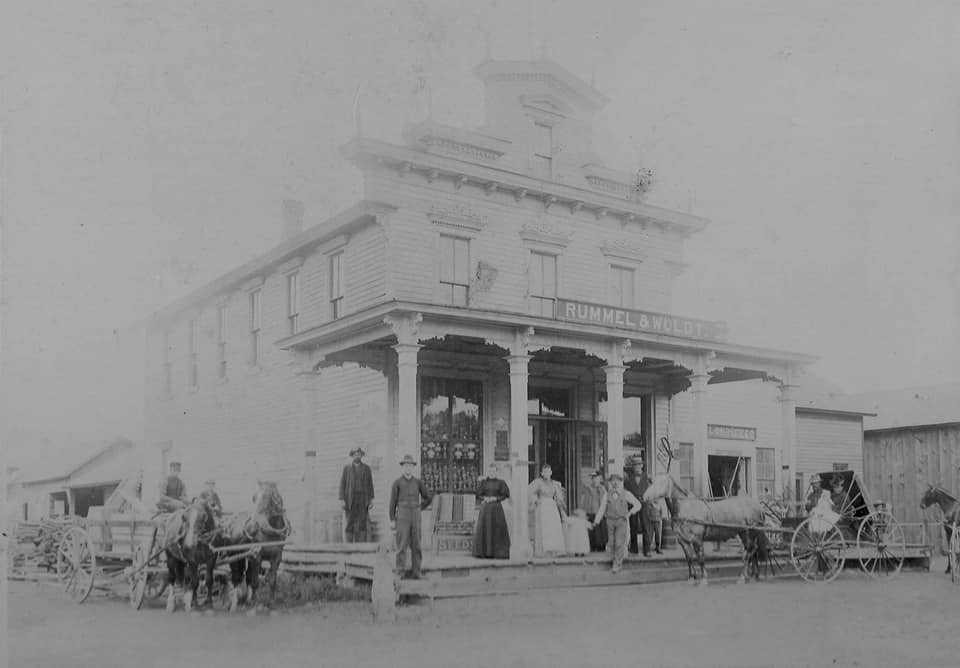
Kilmanagh is a place stuck in lore and time. In the Spring of 1891, this western Huron County village hosted a grist mill, two general stores, a blacksmith shop, and two or three saloons. Only a couple of relics of the village remain. The aging general store, a 1940’s service station, and a closed liquor store. It is an interesting stop on your way north to Bay Port or Caseville. If you stop, treat it respectfully, as it’s literally a museum exposed to the elements.
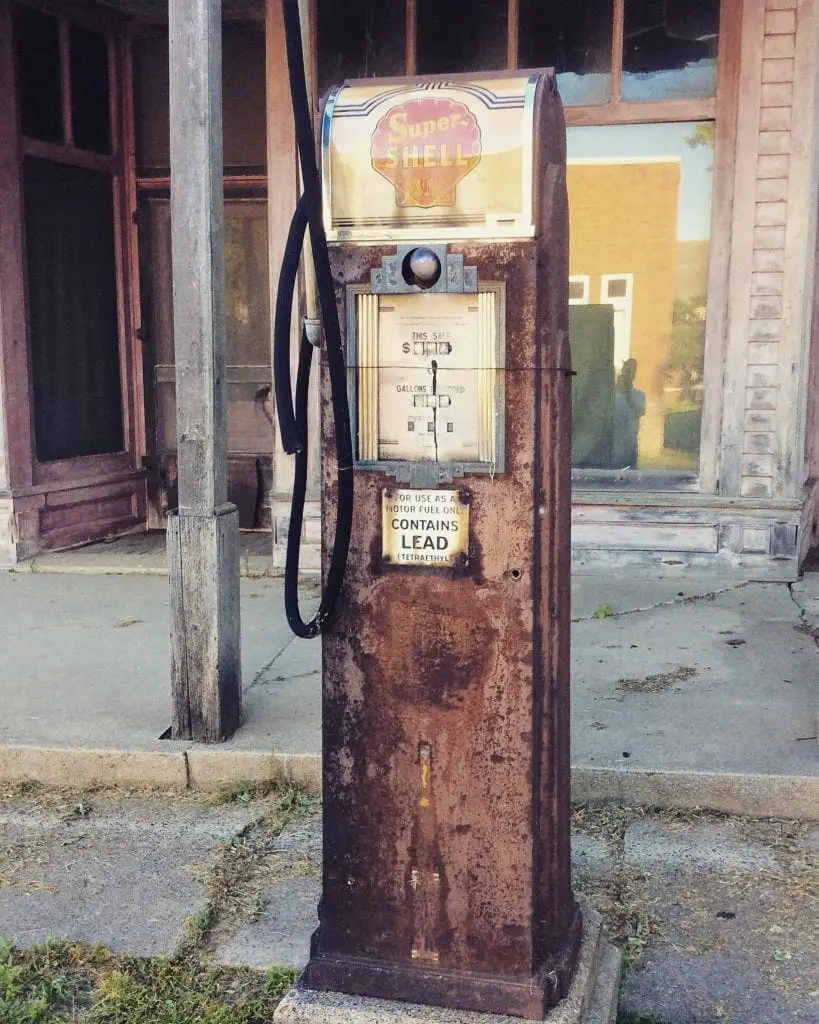
Walk among its ruins. Snapshots and hopefully write a few words on your find. The general store is what takes your attention first. There is beauty in the decay.
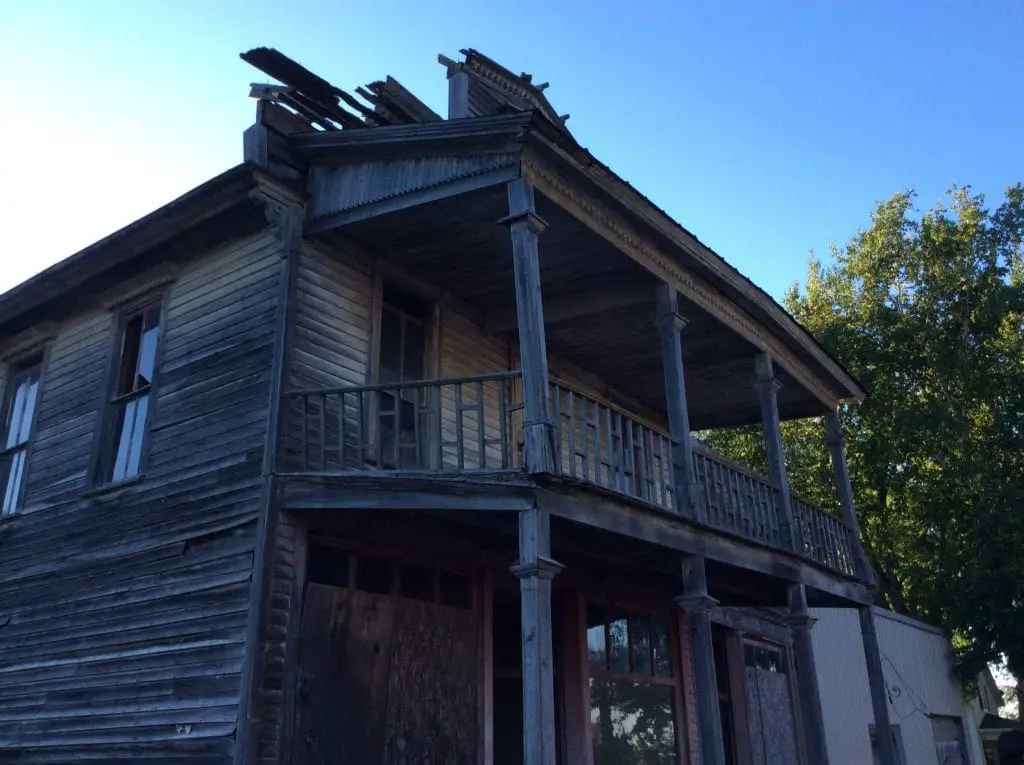
History of Kilmanagh, Michigan (1800s–1960)
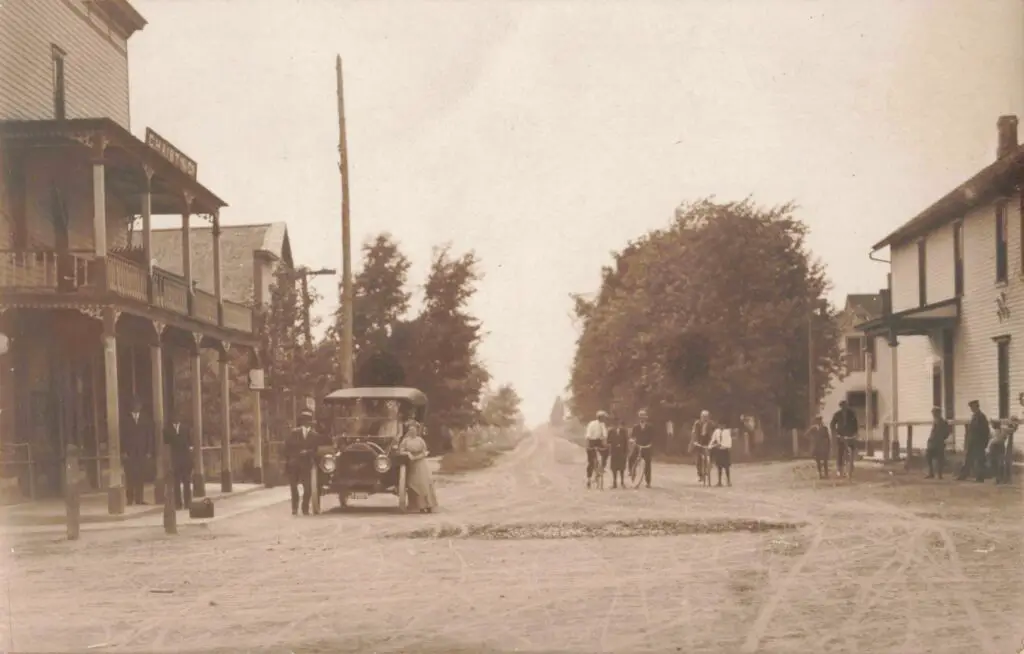
Kilmanagh, Michigan is a rural hamlet in Huron County, located at the junction of four township lines (Brookfield, Sebewaing, Fairhaven, and Winsor). It began as a classic “four corners” settlement – an unincorporated crossroads community – and it played a modest yet vital role in the region’s pioneer era through the mid-20th century. This overview chronicles Kilmanagh’s founding, settlement patterns, economic and social development, notable individuals, and key events from the early 1800s through 1960, including how surrounding area developments shaped its growth and identity. Throughout, Kilmanagh’s story exemplifies the boom-and-bust cycles of Michigan’s Thumb region, from logging days to agricultural heartland, until modern changes rendered it a near ghost town.
Founding and Early Settlement (Mid-1800s)

In the mid-19th century, Michigan’s Thumb area opened to settlement as lumbering and homesteading expanded inland. The site of Kilmanagh was first settled in 1861 by Francis Thompson, an Irish immigrant homesteader. Thompson’s farm sat at a country crossroads, and the fledgling community was initially known as “Thompson’s Corners,” named after its founder. In its earliest years, Kilmanagh was simply a cluster of farmsteads in dense forest; prior to this, the surrounding land had been remote frontier (an Ojibwe mission operated nearby in the 1850s).
Thompson soon gave the locale a new name inspired by his homeland. The name “Kilmanagh” was reportedly adopted from a place in County Kilkenny, Ireland – initially applied to the Shebeon Creek (which runs through the area and overflowed each spring) and later to the settlement itself. By the late 1860s, the small community had a formal identity and was poised to grow as more pioneers arrived.
Emergence as a Four Corners Community
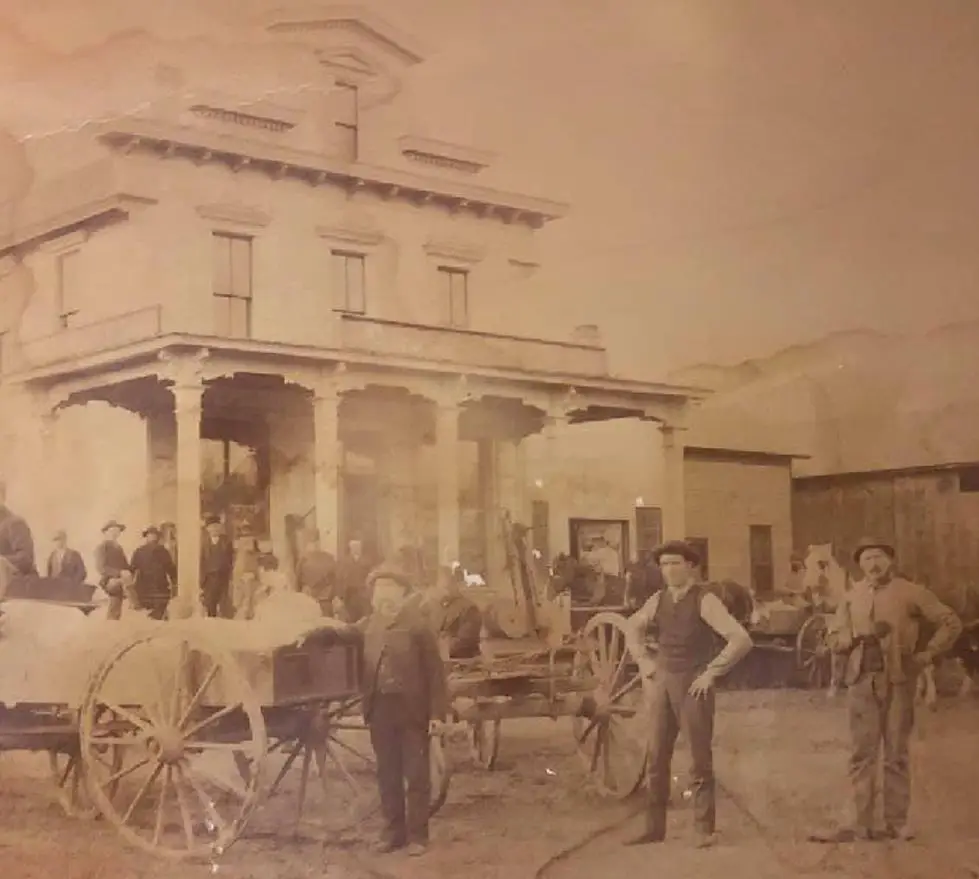
Kilmanagh’s development was part of a broader post-Civil War wave of settlement in Huron County. The village sits at the point where four township borders meet, making it a textbook “four corners” town. David McDonald of the Huron County Historical Society noted that Kilmanagh was one of many such inland corners communities that sprang up after the Civil War as homesteaders moved into the Thumb region. A key driver was the establishment of new transportation routes. In the late 1860s, an early state road (now Kilmanagh Road) was built across the county, connecting the Saginaw Bay port of Sebewaing to the Lake Huron harbor at Harbor Beach. Kilmanagh lay along this route, roughly midway, and thus became a convenient stop and market center for travelers and newly arriving farmers. By the early 1870s, the “Thompson’s Corners” crossroads had evolved into a small but thriving settlement centered on that important county road.
Economic and Social Development (1870s–1900)
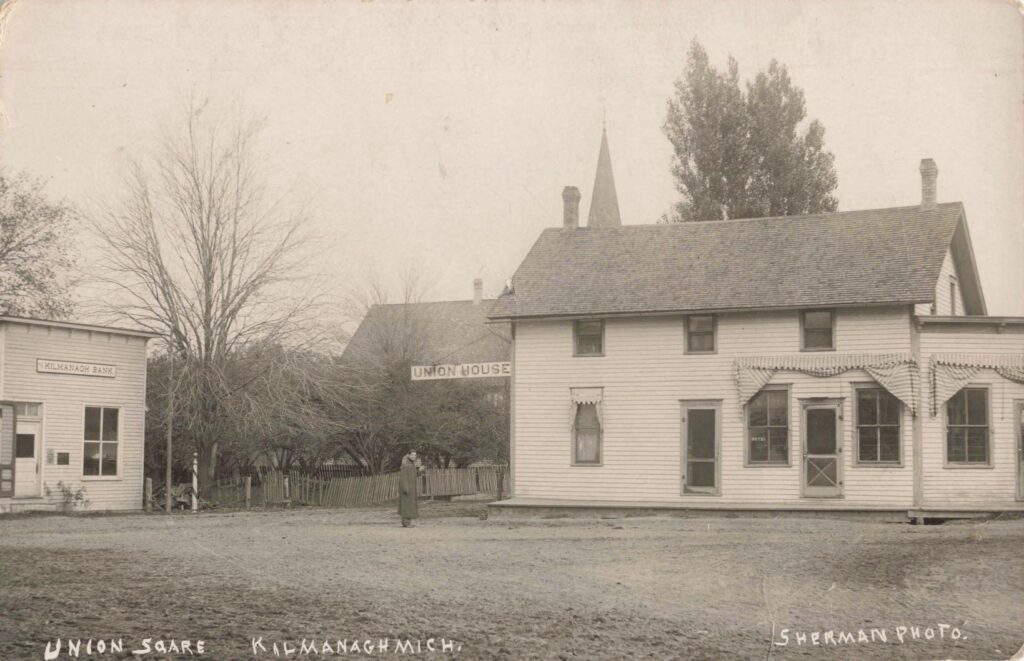
Like many rural Michigan communities, Kilmanagh’s early economy was tied to the lumber industry and later to agriculture. In 1873, a prominent businessman from nearby Sebewaing, John C. Liken, established Kilmanagh’s first general store. Liken had extensive operations (including sawmills and stave mills for barrel-making) and ran branch general stores in several Thumb settlements. He built the Kilmanagh store specifically to supply workers at a local sawmill on the Shebeon Creek. The two-story wooden store even featured boarding rooms upstairs to house lumbermen and other laborers in its early years. This general store quickly became the focal point of the village – a place to buy provisions, pick up mail, and socialize.
Fortunately for Kilmanagh, it escaped the devastation of the Great Thumb Fire of 1881, a massive wildfire that swept through the region’s dried-out slashings. A shift in winds spared the Kilmanagh area while many neighboring communities burned. In the aftermath, as the great forests were depleted and cleared, the economy transitioned to farming. By the late 1880s and 1890s, Kilmanagh had matured into a modest agricultural service center for the surrounding countryside.
Kilmanagh in 1891 – A Farming Hamlet
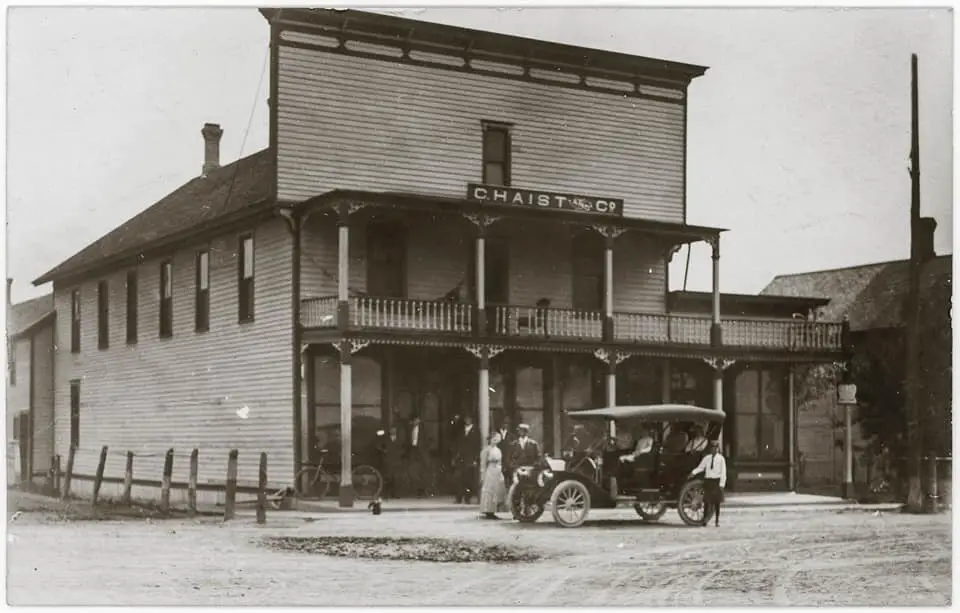
By spring of 1891, Kilmanagh boasted several businesses catering to local farm families.
- General Stores (2): Two competing general stores supplied groceries, dry goods, tools, and hardware. The original Liken store changed hands in this period, and another store operated as well.
- Grist Mill: A grain mill processed farmers’ wheat and corn, reflecting the area’s growing crop production.
- Blacksmith Shop: A blacksmith provided essential services, from shoeing horses to repairing wagons and farm implements.
- Saloons (2–3): At least a couple of saloons or taverns operated, serving as social hubs where locals could gather and share news (or a drink) after a day’s work
These establishments made Kilmanagh a lively rural village in the late 19th century. The presence of multiple stores and taverns indicates the local farm population was large enough to support a small commercial center.
Agriculture dominated the local economy by the turn of the century. The surrounding farmland, carved out of the former pine woods, was particularly known for dairy and field crops. Kilmanagh became known for its dairy farming activity – so much so that in 1903 Edwin Schnabale purchased the Farmer Co-Op called “Kilmanagh Cheese Factory,” underscoring the area’s milk production and the processing of farm goods. In addition, a one-room schoolhouse was built in the vicinity, providing education to children from farm families and further cementing Kilmanagh’s role as a community center.
Social life in Kilmanagh revolved around both informal gatherings (at the stores or saloons) and organized institutions. A notable landmark was St. John’s Lutheran Church, founded in the mid-1870s by German Lutheran settlers in the area (the congregation later celebrated its 75th anniversary in 1951). This church, along with others in nearby towns, served the large number of German immigrants who had moved into Huron County in the late 19th century. In fact, many of Kilmanagh’s residents and business proprietors were of German descent, part of a broader wave of German-American settlement that influenced the Thumb region’s culture. The Lutheran church and the continued use of the German language in the community for many years were testaments to this heritage. Thus, by 1900, Kilmanagh was a small but complete rural community – unincorporated, yet featuring the essential economic and social structures of a country village.
Notable Individuals in Kilmanagh’s History
Several individuals played especially important roles in Kilmanagh’s development between the 1860s and 1960:
- Francis Thompson (Founder): An Irish-born farmer, Thompson established the settlement in 1861 and gave it its first name. He became Kilmanagh’s first postmaster when a U.S. Post Office opened in February 1873. Thompson’s decision to rename the locale “Kilmanagh” after a place in Ireland (inspired by the local creek) left a lasting legacy. He remained a prominent figure in the hamlet’s early years as it grew from a crossroads camp into a community.
- John C. Liken (Entrepreneur): Liken was a successful German-American businessman based in Sebewaing who expanded into Kilmanagh in the 1870s. In 1873 he built the first general store at the four corners, which anchored the village’s economy. Liken also owned sawmills and over a thousand acres of land in Huron County, and he operated general stores in other towns (such as Bay Port, Unionville, and Bach). His investment jump-started Kilmanagh’s development, linking it to a network of Thumb area commerce. Liken’s store supplied lumber camps and settlers alike, and its establishment marks the true beginning of Kilmanagh as a community.
- Christian Haist (Merchant): A German immigrant, Christian Haist became a well-known Kilmanagh merchant in the late 19th century. He owned and ran the C. Haist & Co. General Store, which for a time served as the village’s primary general store and even functioned informally as a post office and community gathering spot. Haist was regarded as a community leader; under his proprietorship, the store was a hub of local information and civic life. His role exemplified the broader influence of German-American settlers in the area’s commercial and social spheres.
- Albert & Clemens “C.P.” Woldt (Storekeepers): Albert Woldt started as a clerk in the Kilmanagh general store in the 1890s and soon became a co-owner. By the turn of the century, Albert’s son Clemens P. Woldt (known as C.P.) took over the business and ran it for several decades. Under C.P. Woldt’s management, the store was renamed C.P. Woldt & Co. and expanded its offerings. Notably, Woldt added a John Deere farm equipment dealership to the general store – reportedly making Kilmanagh home to one of the first John Deere dealerships in Michigan. This savvy diversification reflected the needs of the farming community and kept the store relevant well into the 20th century. The Woldts, father and son, thus bridged the gap between the pioneer era and the modern era in Kilmanagh’s commercial life, operating the cornerstone store until the early 1960s.
20th-Century Changes and Decline
By the early 20th century, several factors were converging that would limit Kilmanagh’s growth. Unlike some neighboring villages, Kilmanagh never attracted a railroad line, which greatly impacted its fortunes. As a 1922 county history noted, the hamlet remained small largely because it was “several miles from any railroad”. Railroads were the economic lifelines for many towns around 1900 – for example, nearby communities like Pigeon and Bad Axe boomed after rail connections – but Kilmanagh, bypassed by the tracks, had to rely on farm wagons and later automobiles for trade. This relative isolation kept Kilmanagh’s population and businesses modest in scale.
Another turning point was the loss of its post office. The Kilmanagh post office, which had operated since 1873, was discontinued in June 1904. Mail service was henceforth handled through larger towns (Sebewaing’s post office assumed the area’s mail route). The closure of the post office was a common fate for many tiny rural communities in the early 1900s and often signified a decline in a town’s official status and importance. Without a railroad or post office, Kilmanagh entered the mid-20th century as a quiet crossroads serving a purely local market.
Despite these challenges, Kilmanagh did not disappear overnight. Through the 1920s–1950s, it persisted as a focal point for the surrounding farms, thanks largely to the enduring general store and a few other enterprises. A service station was opened by the 1940s, installing a gas pump at the corner to cater to motorists on the country roads. A small roadside tavern or liquor store also operated mid-century, continuing the tradition of hospitality on the corner. St. John’s Lutheran Church remained active, and the community retained its identity even as residents increasingly drove to bigger towns for many needs.
However, the overall trend in this period was one of contraction. Younger generations left for opportunities elsewhere, farms consolidated, and rural population dwindled. The improved road network and the rise of automobile travel after World War II meant that even routine shopping could be done in larger neighboring villages or at new supermarkets, reducing the necessity of a local general store. By around 1960, Kilmanagh’s role had vastly diminished compared to its 19th-century heyday.
The symbolic end of old Kilmanagh came with the closure of its landmark general store. After nearly 90 years in business, the Woldt general store (originally Liken’s store) finally shut its doors in 1963. C.P. Woldt could no longer keep the operation viable in the face of modern competition and a shrinking customer base. With the store’s closure, Kilmanagh essentially ceased to function as a commercial village. What remained were a handful of homes, the church, and memories of a once-thriving four-corners community.
By 1960, then, Kilmanagh had come full circle: from a pioneer outpost born in the 1860s, through a bustling farm-town crossroads around 1900, to a fading country crossroads in the mid-20th century. Its story was shaped by the big forces of Michigan’s history – lumber booms and fires, railroad routes and road building, waves of immigrants and agricultural change. Kilmanagh’s legacy endures in its surviving historic buildings (notably the old general store, now undergoing restoration) and in the local lore of Huron County. The period from the 1800s through 1960 saw Kilmanagh rise as a vital “four corners” hub and later decline as progress bypassed it, encapsulating the fortunes of many such rural Michigan communities in that era.
I’m lucky to have been given a set of pictures of Kilmanagh from my mother. In the late 1980s, my parents had a small business called Thumb Impressions. They had the opportunity to travel around the Thumb in a 1990 LeBaron GT convertible to capture the Thumb as it had been. The area was changing, and many of the WWII generations were passing on. With it were some of the landmarks of the area.
Kelly’s Bar 30 Years Ago in Kilmanagh
This set of photos was taken around 1990 in Kilmanagh. The lovely lady tending bar that day was Bernice Kelly. From the comments from those who remember those times, she had a great sense of humor. Someone asked her for a dark beer. She replied, “All my beer is in brown bottles…”




By 2016 the bar and shop are closed. When last I drove by the building, it was still neat and tidy and it looked like it could be opened in short order. Like many small Michigan villages, there is no vibrant business other than the spectacle of decaying past glory. This is depressing. I wonder if these beautiful four corner villages will ever rebound.
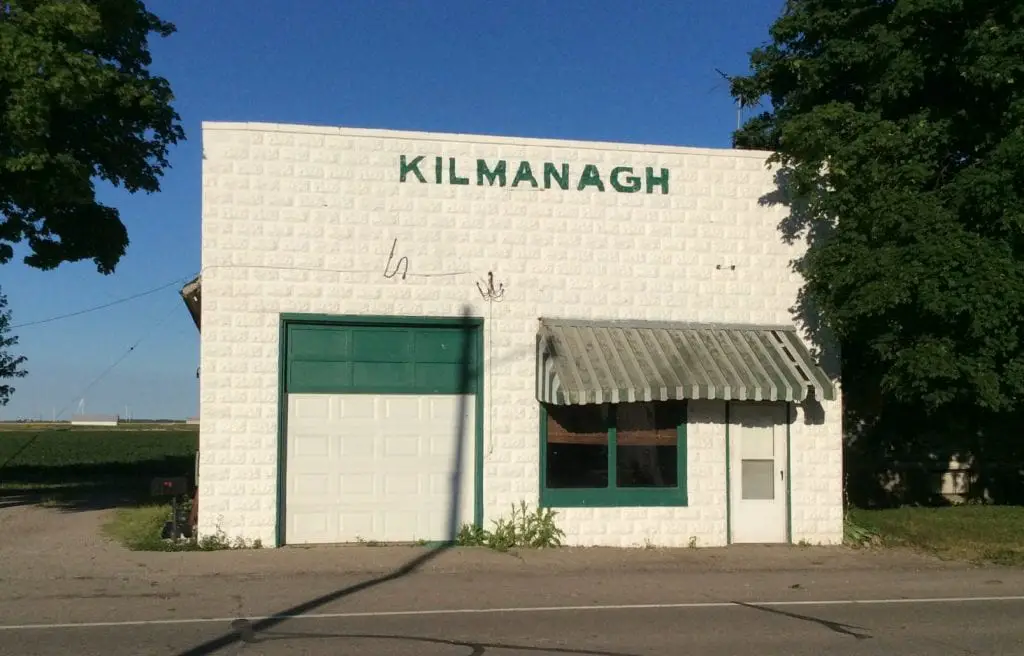
Kilmanagh: An Artist Delight and Hopeful Restoration









Kilmanagh is a gold mine for still-life artists. A modeling artist in Germany did a scale model of the general store. (If anyone knows who that is please pass it along) The best example of someone who really invested himself in this is John Nagridge, who in several seasons, painted Kilmanagh Fall, Winter, and Spring themes. You can visit John’s website for more knife renderings of Kalmanagh’s general store.
In 2017 the owners of the Kilmanagh General Store began restoration work. Which is a hopeful sign. Visit their Save the Store page for more information on how you can help save the Kilamanagh General Store. You can also visit the Kilmanagh General Store Facebook Page and check out the progress of the restoration efforts.
Michigan Small-Town Getaways
- Michigan’s Bean Town and Polka Capital – Kinde – Many want to keep this place a secret. It’s a slice of a true American farming community in the Thumb of Michigan. John Kinde founded the village in the 1880s during the region’s transition from lumbering to agriculture. A lumber yard, general store, grain elevator, and post office were established, followed by a train station in 1882 for the Port Huron and Northwestern Railroad.
- The Pinnebog General Store – Gone But Not Forgotten – Walter Hume, “the Daniel Boone of Hume Township,” became the first settler in the area in 1844. This little four corner settlement was first called Pinnepog (Chippewa for partridge drum). However, another Pinnepog five miles north on Saginaw Bay, so this one changed to Pinnebog (“a high sounding and dignified way of saying pine bog”).
- The 1881 Fire that Almost Wiped out Parisville – The Great Michigan Fire of 1881 devastated one town above all others; Parisville. Parisville, Michigan, was founded by Polish immigrants escaping the Prussian Empire’s oppression; this community claims to be the first Polish settlement in North America.
- The Corner Drug & Jewelry Store Harbor Beach, Michigan – The Corner Drug and Jewelry Store in Harbor Beach is estimated to be 1910. It shows a steam tractor towing a wagon and another team following behind. Originally I wanted to focus on the tractor. I still don’t know what the make is, but I suspect it may have been a Case.
- Marlette Railway Depot – The railroad was key to the economic growth of the Thumb’s agricultural business. By 1910 Marlette Railway depot was twice a day stop for passengers and freight between Port Huron and Saginaw.



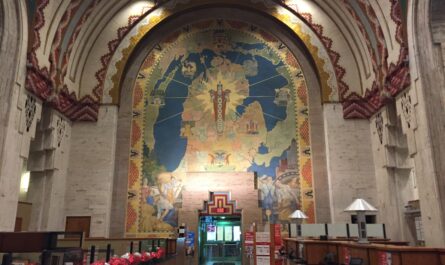
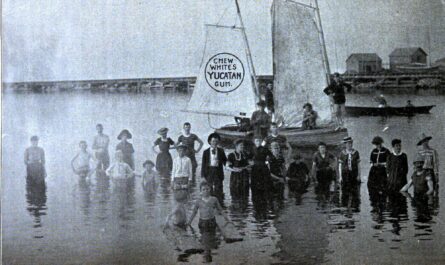

I just saw this article. Thanks so much for mentioning me and my paintings (which anyone can view at johnnagridge.com). I’ve been in love with this building for almost 2 decades! I pass it on my way to my in-law’s cabin and always stop for a minute or so to admire it.
I was fortunate enough to be able to do a plain air painting of it on the spot a few years ago. The owner and the neighbors were very friendly when they approached me and told me great stories. I was told the Henry Ford Museum might be interested in that awesome gas pump. I hope they get it before it gets vandalized any more. Why would anyone want to wreck it?
As for the General Store in Bach, my wife and I did get to peruse inside there a couple years ago when it was open as an antique store. The owner said he wanted to close it and move to California. From the sounds of your article, it sounds like he made it.
I should get you acquainted with my friends at White Church Gallery in Grindstone City. I think Mike and Carrie would find your work an awesome edition. Local Thumb content is wanting here. Will you find your way back up here this summer?
Definitely head up a few times every spring/summer. I love painting in the Thumb. And being married to a family of great ice-cream lovers, we always find our way to Grindstone!